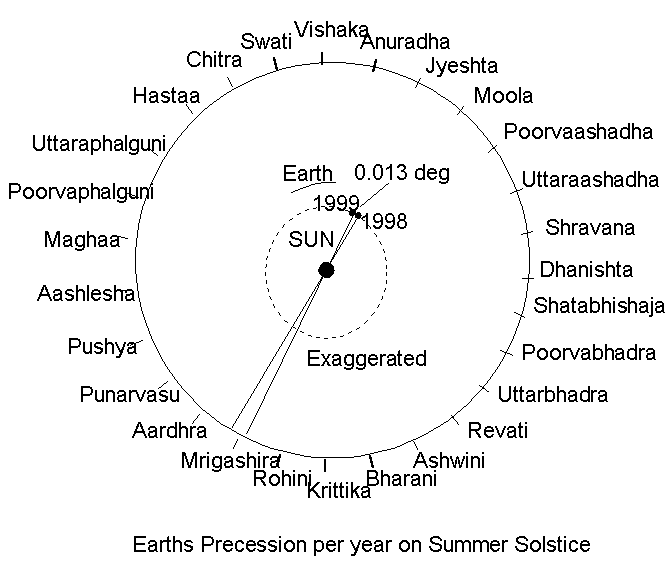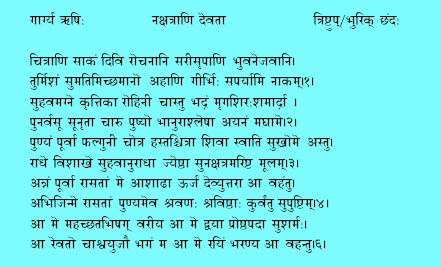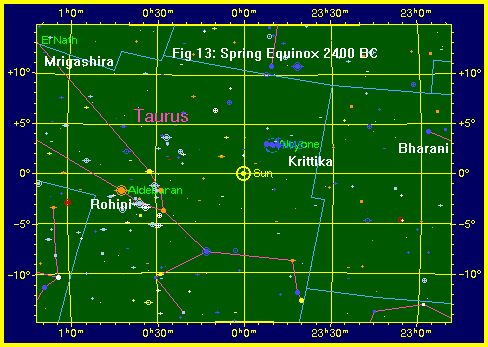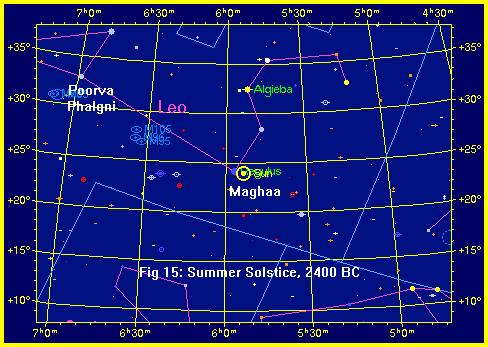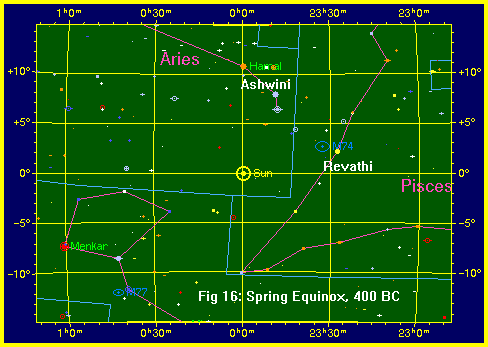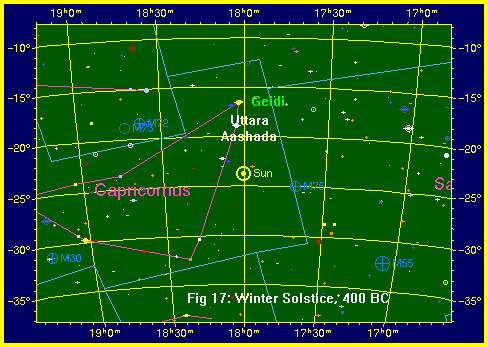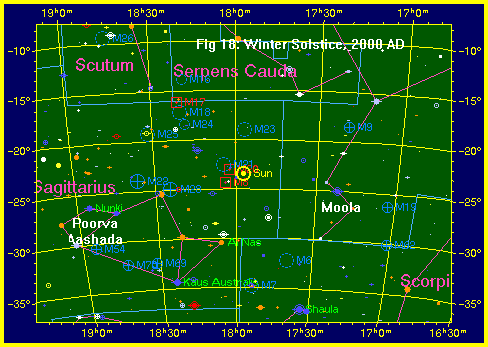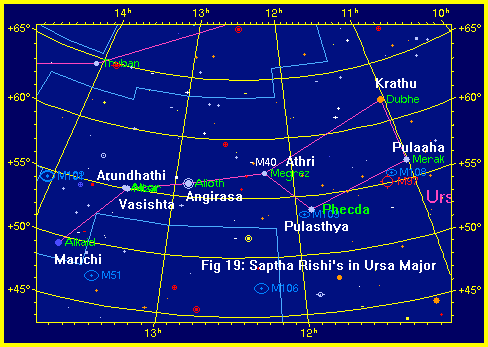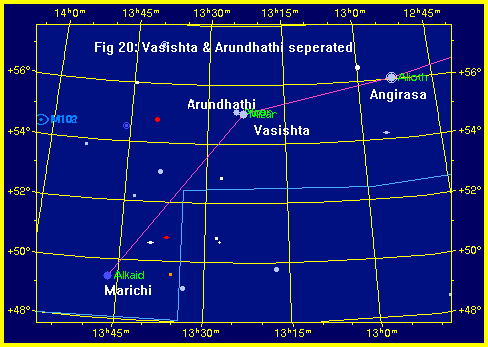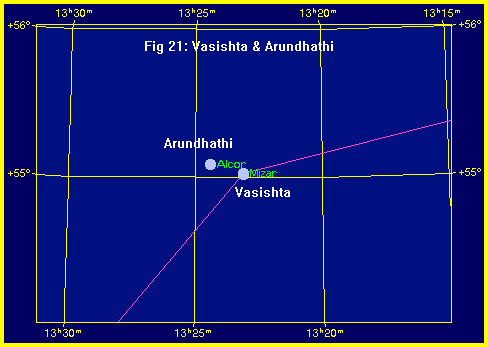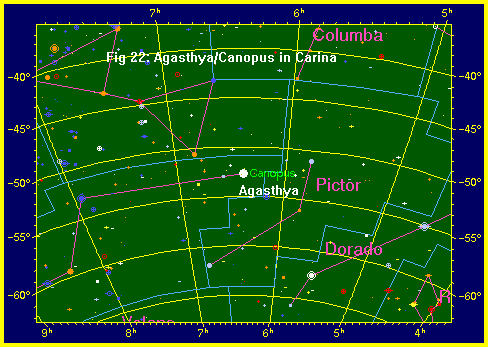 |
 |
|||||||||
|
||||||||||
Introduction Bharateeya Nakshatra system History of star names Loadstar software Mesha or Aries Vrishba or Taurus Mithuna or Gemini Karkataka or Cancer Simha or Leo Kanyaa or Virgo Tula or Libra Vrischika or Scorpio Dhanu or Sagitarius Makara or Capricorn Kumbha or Aquarius Meena or Pisces Conclusion Appendix References
|
Astronomical time marks in Atharva Samhita & Jyotishya shaastra. When was Atharvana Samhita composed? Though we consider that the Star system to be basically stationary with reference to Solar system, there is an earth wobble occurring at rate of 26000 years per revolution which makes the star system appear to move slowly with reference to Sun. This has been called Earth's Precession and was first identified nearly 2000 years ago by Ptolemy and Hipparchus. The position of Chitra (Spica), which is very near the ecliptic, was recorded by Hipparchus (circa 150 BC) on the autumnal Equinox day with reference to Sun. It was studied again by Ptolemy (circa 150 AD) nearly 300 years later on same autumnal Equinox day. Ptolemy found that Chitra appeared to have moved about 3 degrees toward Sun (Ref 4). Ptolemy decided that Sun was moving one degree for 100 years in reference to stars. This observation made nearly 2000 years ago, was probably the first documented recording of Earth's Precession. Today we know that Ptolemy was correct and that Earth's Precession rate is about 1.36 degrees for 100 years. This 2000-year old observation, confirms the uniformity of Earth's Precession validating the geocentric mathematical models that exist for motion of objects in the sky. It allows us to extrapolate backward and forward in time, positions of objects in sky using computer software like Load Star pro. Thus, any past Sun position records, on Equinox/Solstice days referring Sun position to stars, carries the astronomical time mark of the period (Ref-8). There are two possible definitions of a year as observed from Earth. A Sidereal year is time taken for Sun to move from one star, and then come back to same star. This is full 360 degrees movement of Earth around the Sun. A Solar year is the time taken by Sun in its passage from one equinoctical point back to same point. One would expect these two years to be same, but Solar year is shorter than Sidereal year by about 19 minutes and 50 seconds and is said to be caused by inertial effects. It is called Earth's Precession. First let us get a contemporary picture of the location of our solar system in the Milkiway galaxy. This is illustrated in figure below. Our solar system is located at the edge of the Milkiway disk of stars. The Milkiway is estimated to be about 50000 light years in its diameter. It consists of a large number of stars and other matter. The stars visible to our naked eye are generally within a few hundred light years around us. Some giant stars are located nearly 1000 light years are also visible to naked eye. Thus most of the 10000 stars visible to us are very near our solar system. In the illustration below, the center of Milkiway Galaxy is in the direction of Moola nakshatra. Thus bulk of the Milkiway matter is concentrated, as seen from earth, near stars Jyeshtha, Moola, Poorva/Uttarashadha.
Because of Earth's Precession, the angle of earth's motion to come back exactly to same latitude (Solar year) is only 359.864 degrees around the sun. Solar year is the classical definition of a year, as the 23.5 degrees earth's tilt controls the weather, seasons and the position of Sun in its north-south traverse. A notional 360 degrees Sidereal year is irrelevant to us.
But the 359.864 degrees Solar year is relevant because of repeating weather and seasons and hence Solar year is a natural year. That means every solar year, the Sun position drops back by about 0.0136 degrees with respect to stars. Also, it may be noted that the earth’s spin polar axis also shifts by same angle of 0.0136 degrees per year in a coning motion. Most popular books on Stars illustrate this spinning top like coning motion property of Earth's Precession, but do not illustrate the apparent ecliptic plane motion of stars. The diagram below illustrates the star shift in the ecliptic due to Precession on spring equinox day. The diagram shows the 27 nakshatra's in a circle of diameter of the order of few hundred light years with sun at the center. The diagram below shows the effect of Earth's Precession on Sun/Star/Earth's position exactly at the time of Spring Equinox. In this diagram, the Sun is always on equator and the day time equals night. Diagram shows Earth's position from 2400 BC to 2000 AD. Every year, the Earth's seasons start occurring 0.0136 degrees (or roughly 0.0136 days) earlier. The diagram also shows twenty-seven Bharateeya nakshatra's in the infinite distance in the ecliptic plane. It should be noted that the Precession does not change the Equator position or the Earth's tilt of 23.5 degrees. It only changes the direction of polar axis.
The Bhaarateeya Veda's have left some astronomical time marks in the texts. Amongst the Veda's, Atharvana Veda is considered to be chronologically the last. Based on the identification of the twenty-seven Baharateeya Nakshatra's, and using the astronomical time markers in Atharvana veda's 19th kaanda/ 7th sooktha. it is possible to to identify when the last of the veda's, Atharvana Veda was composed. The Atharva veda 19th kaanda/7th Sooktha reads, Atharvana Veda Kaanda 19 / Sooktam 7
Gargya Rishi! Nakshatrani Devata! Trishtup-Bhurik Chandaha! Chitrani sakam divi rochanani sarisrupani bhuvanejavani turmisham sumatimichaamaano ahaani geerbhi saparyami nakam!1! suhavamagne krittika rohini chaastu bhadram mrigashirah Sham aardhrah ! punarvasu soonruta chaaru pushyo Bhaanur aslesha ayanam magha mey !2! punyam poorva Phalguni chottra hasta schittra shiva swaati sukho mey astu! raadhe vishaakhe suhav anooradha jyeshta sunakshatramarishta moolam !3! annam poorva raasataam aashadha oorja devy uttaraa aavahantu! abhijinma raasataam punyameva shravanah shravishtaah kurvatam supushtim!4! Aa mey maha chatabhishagam vareeya Aa mey dvaya proshtapadaa susharma! Aa reyvato chashvayujow bhagam ma Aa mey rayim Bharanya aavahantu!5! This Sookta dedicated to Nakshatra's was recorded (Drashtaara) by Gargya Rishi. The Sookta describes both astronomical and astrological elements. Twenty eight Nakshatras are identified starting with Krittika and reference is made to Ayanam occurring in Maghaa. A nakshatra Abhijit is shown between Uttarashadha and Shravana. Its use has been discontinued in the Jyotishya with only twenty seven identified currently. The authenticity of the Athrarvana texts is well accepted, by the very reverence shown towards precise learning. Hundreds of generations of Shrotreeya's have carried veda's down to us in its original language using oral traditions of Krama, Pada, Jatha, and Ghana Paatha so that distortions are nonexistent. Two major astronomical time markers are evident and implicit in the Sooktha. They are, 1. Rishi Gargya starts the list of twenty seven nakshatra's starting with Krittika. Choice of Krittika as the first of twenty-seven is very significant. In contrast Jyotishya Shaastra uses Ashwini as the first star. The choice of first Nakshatra must correspond to a logically first day of a solar year, which dictates the weather cycles. Which is the year’s first day? Astronomically speaking, the spring Equinox day in Northern Hemisphere temperate zone is a logical one. It heralds the arrival of the spring, in temperate zone of northern hemisphere of the earth. Vasantha ritu, the spring has always been considered as beginning of a year from Rig-vedic times. Hence, the first observation implicit in Rishi Gargya's sooktha is that on spring Equinox day, Sun was at Krittika Nakshatra. Figure 13 shows Sun location on March 21, 2400 BC from Load Star Pro. The Sun is on equator and is pointing to Krittika nakshatra.
Compare this to Figure 14 which shows Sun 4400 years later, on March 21,2000 at same equator but Sun is on Poorva Bhadrapada. Thus Sun has Precessed by about 57 degrees in 4400 years since Rishi Gargya's Sooktha. 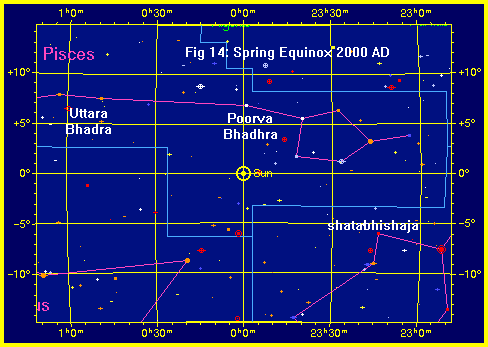
2. Rishi Gargya refers to Ayana occurring in Maghaa during his time. Ayana refers to apparent direction of Sun's North-South motion. The day of direction reversal is called an Ayana day (Uttara and Dakshina Ayana). When Rishi Gargya refers to Ayana he is clearly referring to a Solstice day and that Ayana occurred when Sun is at Maghaa.
It could be either Dakshina Ayana(Summer Solstice ) or Uttara Ayana(Winter Solstice). Let us look at Load Star pictures of Sun at Daskhina Ayana (Summer Solstice) 4400 years ago. Figure 15 shows the Sun at +23.5 degrees on June 21, 2400 BC. This is the day of Dakshina Ayana. Sun is clearly at Maghaa Nakshatra. Rishi Gargya's Ayana could also be Uttara Ayana, (Winter Solstice), but it fails because the first nakshatra would then have to be Hasta or Chitra and the date would be 22000 BC. The Soothra indicates Krittika as the first. The diagram below shows the picture of Earth's position over past 4500 years on Summer Solstice day when Sun reaches the peak northern position of +23.5 degrees and starts his southern movement (Dakshina Ayana). The Sun position as observed from earth in 2400 BC on this day would be at Maghaa. In circa 400 BC, Sun would be in Pushya. Today, Sun is between Mrigashira and Aardhra.
Hence Rishi Gargya's Atharvana Veda 19 Kaanda and Sooktha 7, clearly has two astronomical time markers and provide a clue as to when it was composed. It is easy dismiss that the starting of Nakshatra list with Krittika as an accident, but recording of star locations which are true for both Equinox and Solstice in same sookta can not be accidental. It suggests a well understood contemporary knowledge of motion of Sun, Moon and Stars in the skies. While such knowledge may have been more thoroughly documented in other texts, only a brief poetic indication of that knowledge appears to have been made in the veda's. Clearly, both the astronomical markers recorded by Rishi Gargya in Atharva Veda kaanda 19 sookta 7 would be correct only near about circa 2400 BC. This must certainly be incontrovertible proof that Rishi Gargya's Sookta was composed near 2400 BC, dating Atharvana Veda to at least 2400 BC. When was Jyotishya Shaastra brought to presently used form?As previously observed, the Earth's Precession makes the Sun move back one degree along the ecliptic in about 76 years with reference to star system. All Sun position references in past with reference to stars on days of Sun singularity, thus carry the astronomical time mark. Bhaarateeya Jyotishya shaastra probably was brought to the presently used form, at a time when old vedic chandramana and all other data was integrated with Raashi or Zodiac based concepts. The time at which this was done can be identified using following. 1. Jyotishya Shaastra starts the lists of Nakshatras with Ashwini, suggesting that Sun was at Ashwini on Spring Equinox day in that period. 2. Jyotishya states that Uttara Ayana starts exactly when sun enters Makara (Capricorn) suggesting that Sun was near Uttaraashadha on Winter Solstice day (Gregorian Dec 21). Sic'Yasmin Kshane sooryam gachati Makaram; tatah prabhruti shanmasa udagayanam. from Rudra Skanda Bashya (10th century AD) of Khadhira Grihya Sutra (4 century BC). Use of Load Star Pro and scan of Sun position over past few thousand years yields following results. Figure 16 shows the position of Sun on Spring Equinox day of 400BC (March 21).
The sun is on equator and is clearly at Ashwini Nakshatra. This explains as to why Jyotsihya Shaastra starts the nakshatra list from Ashwini. The figure showing the position of Earth, Sun on Spring Equinox Day in previous section also confirms the fact that Sun would at Ashwini. As already illustrated now sun is at Poorva Bhadrapada. Nakshatra listing today must start from Poorva Bhadrapada. Figure 17 shows the position of sun on Gregorian December 21(winter Solstice),the start of Uttara Ayana in 400 BC. Clearly the sun is at +23.5 degrees and near Uttara Aashadha near Makara Raashi. This supports the Jyotishya statement that Uttara Ayana occurred when Sun entered Makara near about 400 BC.
Compare this to figure 18, which shows the position of sun on December 21, 1998. Thus sun is clearly at Dhanu Raashi and not at Makara.
Thus the twin observations of Jyotishya Shaastra, (of the Spring Equinox and Winter Solstice) are valid only near 400 BC and hence that is the period when it probably took the present form. It is clear that Bharateeya astronomers who knew of the astronomical information carried down from vedic culture, looked at Western Zodiac based system and then merged the two to form present Jyotishya Shaastra. Hence Jyotishya uses both the 27 Nakshatra's and 12 raashi's. It should be noted that the Western Zodiac system appears to have been frozen at same time period. It uses Aries as the starting Zodiac in recognition of Spring Equinox occurring at time of entry of Sun to Aries. Astronomical identity of Saptha Rishi's, Dhruva & ArundhathiOn the night of the marriage, Bhaaratheeya brides are shown a star called 'Arundhathi' in the night sky. Arundhathi is the wife of sage vasishtha. This couple is revered as a loving and ideal couple worthy of emulation, because of their devotion to each other and harmony. Vasishtha is one of the seven rishis. The seven stars in the northern sky was named 'saptha rishi mandala', and it is more popularly known as 'Ursa major' constellation. It is also called 'Great bear' or 'Big Dipper'. The astronomical identity of these stars is very easy to establish due to explicit definitions given by Varaha Mihira in his Brihat Samhita (circa 550 AD). There are two sets of definitions as to who the saptha Rishi's are. The vedic tradition is 'Gautama, Vishwamithra, Jamahagni, Bharadwaaja, Kashyapa, Vasishtha and Athri' are the saptha rishis. However, the saptha Muni's according to Varahamihira are' Marichi, Vasishtha, Angirasa, Athri, Pulasthya, Pulaaha, and Kruthu'. V.S.Apte in his famous Sanskrit-English dictionary (circa 1800) also concurs with later definition. Vasishtha and Athri figure in both the lists. However, V.S.Apte refers to Arundhathi being a star in the pleiades group or Krittika of our vedic tradition. Pleiades is far away from Ursa major. Clearly Apte's definition deviates from Varaaha Mihira's identity of Arundhathi. The later is more logical in that Arundhathi must accompany Vasishtha. Varaaha Mihira explicitly identifies the Ursa Major and provides the proper names of seven dominant stars, and attributes the origin of these names to sage 'Vruddha Garga'. In all probability 'Vriddha garga' is same as 'Gargya Rishi' of Athrvana veda 19 kaanda 6-7 sooktha whose time was approximately 2400 BC. He is referred to in Mahabharatha as the person who named Krishna, and is considered as Achaarya of vedic astronomy. Varaaha Mihira in his Brihat Samhitha, dedicates 13 kaanda to Saptha Rishis. The first six verses provide following descriptions translated as:
These descriptions provide us with adequate information about the explicit astronomical identity of the nine stars, called as Dhruva, Arundhathi & saptha Rishis's. Figure 19, 20 and 21 illustrate Load Star Pro views of the 'Ursa major', with zoom in to 'Vasishta-Arundhati' pair. This constellation is known in Northern Hemisphere as rotating around the pole star Polaris. Thus 'Dhruva' clearly is Polaris. The saptha Rishi's are the seven major stars of Ursa major. We can easily identify from figure 19, that 'Marichi' stands for Alkaid, 'Vasishta' stands for Mizar, 'Angirasa' stands for Alioth, 'Athri' stands for Megrez, 'Pulasthya' stands for Phecda, 'Pulaaha' stands for' Merak and 'Krathu' stands for DuBhe. The companion star for Mizar is Alcor. Hence 'Arundhathi' stands for Alcor. In figure 19, Vasishta and Arudhathi (Mizar-Alcor) can not be seen separate.
As we zoom in, illustrated by figures 20 and 21, the separation between Vasishtha and Arundhathi become evident.
The star Arundhathi is difficult to separate from Vasishta for people with poor eyesight. Arundhathi's brightness is 4 and is within 0.2 degrees of Vasishtha whose brightness is 2.2. This makes it difficult to separate them.
The table above provides the modern astronomical identity of the nine stars from vedic period which are not in the ecliptic. Dhruva is not illustrated in any of the figures, as its identity is very well known in the sky. In Bhaaratheeya culture, anecdotally people who are approaching death can not separate Arundhathi from Vasishta and hence can not see Arundhathi. The gap between Vasishtha -Arundhathi is said to be widening due to proper motion and it is now a days relatively easier to see them seperately, while few thousand years ago it was more difficult. In other cultures of the world also, historically in ancient times, keenness of eyesight was measured by the ability to distinguish the two stars Vasishtha-Arundhathi (Mizar-Alcor). Astronomical identity of Vedic star AgasthyaWhile the 27/28 daily stars Krittika to Bharani are in the ecliptic plane, the Saptha Rishis in the extreme north near the Dhruva/Polaris, only one star in the southern sky has been named during vedic period. It is Agasthya (canopus). Agasthya Rishi crossed vindhya mountains southwards and it is a major event in the vedic chrononlogy. He is held in great reverence in the south and associated with Lopamudhra his wife. Thus it is not surprising that a star in southern extreme is named after Agasthya. The astronomical identity of Agasthya can be determined based on Varaaha Mihira's work Brihat Samhita(Ref 12). He has dedicated the whole of 12th kaanda (chapter) to Agasthya Rishi. Varaaha Mihira(550 AD) again refers to the authority of Rishi Vriddha Garga (2400 BC ) in identifying Agasthya. This identity is not as explicit as the Saptha Rishi's, but he gives the season in which Agasthya is visible. That means the star was not visible during nearly 4-5 months near summer at Ujjain where Varaaha Mihira was located. Based on this, it is very easy to identify the star as Canopus in constellation Carina as Agasthya. Canopus is 53 degrees south, and in summer when earth tilts 23.5 degrees north, people north of Tropic of Cancer can not see Canopus, because of daylight and being down in horizon. The figure 22 shows the star Agasthya Rishi.
Agasthya is so far south that people in Northern Hemisphere, like New York, Athens etc can never see Agasthya. Agasthya and Constellation Carina are not even shown in popular star charts and books sold in USA. Agasthya is best visible in the winter months near winter solstice for people living south of 25-30 degree latitude as the dark period increases in Northern Hemisphere. People living in Australia, can easily see Agasthya most of the time. The brightness of this star is very high at -0.72. Amongst the 37 stars (including daily stars Krittika to Bharani, Saptha Rishi's, Arundhathi, Dhruva and Agasthya), Agasthya is the brightest of them all. Following table provides the formal astronomical identity of Agasthya.
|
||||||||||||||||||||||||||||||||||||||||||||||||||||||||||||||||||||||||||||||||||||||||

